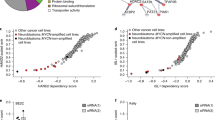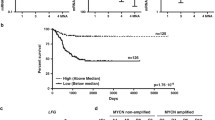Abstract
A major prognostic marker for neuroblastoma (Nb) is N-myc gene amplification, which predicts a poor clinical outcome. We sought genes differentially expressed on a consistent basis between multiple human Nb cell lines bearing normal versus amplified N-myc, in hopes of finding target genes that might clarify how N-myc overexpression translates into poor clinical prognosis. Using differential display, we find the previously described growth-inhibitory gene Ndrg1 is strongly repressed in all tested Nb cell lines bearing N-myc amplification, as well as in a neuroepithelioma line with amplified c-myc. Overexpression of N-myc in non-amplified Nb cells leads to repression of Ndrg1, as does activation of an inducible c-myc transgene in fibroblasts. Conversely, N-myc downregulation in N-myc-amplified Nb cells results in re-expression of the Ndrg1, and stimuli known to induce Ndrg1 do so in Nb cells while simultaneously down-regulating N-myc. Relevant to these results, we demonstrate an in vitro interaction of Myc protein with the Ndrg1 core promoter. We also find that Ndrg1 levels increase dramatically during in vitro differentiation of two cell lines modeling neural and glial development, while c- and N-myc levels decline. Our results combined with previous information on the Ndrg1 gene product suggest that downregulation of this gene is an important component of N-Myc effects in neuroblastomas with poor clinical outcome. In support of this notion, we find that re-expression of Ndrg1 in high-Myc Nb cells results in smaller cells with reduced colony size in soft-agar assays, further underscoring the functional significance of this gene in human neuroblastoma cells.
Similar content being viewed by others
References
Berthold F: Overview: Biology of neuroblastoma. In: C. Pochedly (ed). Neuroblastoma: Tumor Biology and Therapy. CRC Press, 1990, pp 1-27
Brodeur GM, Castleberry RP: Neuroblastoma. In: PA Pizzo, DG Poplack (eds). Principles and Practice of Pediatric Oncology. Lippincott, PA, 1993, pp 739-767
Reynolds CP, Tomayko MM, Donner L, Helson L, Seeger RC, Triche TJ, Brodeur GM: Biological classification of cell lines derived from human extra-cranial neural tumors. Adv Neuroblastoma Res 2: 291-306, 1988
DePinho RA, Schreiber-Agus N, Alt, FW: myc Family oncogenes in the development of normal and neoplastic cells. Adv Cancer Res 57: 1-46, 1991
Henriksson M, Lüscher B: Proteins of the Myc network: Essential regulators of cell growth and differentiation. Adv Cancer Res 68: 109-182, 1996
Seeger RC, Brodeur GM, Sather H et al.: Association of multiple copies of the N-myc oncogene with rapid progression of neuroblastomas. N Engl J Med 313: 1111-1116, 1985
Peters MA, Taparowsky EJ: Target genes and cellular regulators of the Myc transcription complex. Crit Revs Euk Gene Expr 8: 277-296, 1998
Coller HA, Grandori C, Tamayo P, Colbert T, Lander ES, Eisenman RN, Golub TR: Expression analysis with oligonucleotide microarrays reveals that MYC regulates genes involved in growth, cell cycle, signaling, and adhesion. Proc Natl Acad Sci USA 97: 3260-3265, 2000
Weiss WA, Aldape K, Mohapatra G, Feuerstein BG, Bishop JM: Targeted expression of MYCN causes neuroblastoma in transgenic mice. Embo J 16: 2985-2995, 1997
Li LH, Nerlov C, Prendergast G, MacGregor D, Ziff EB: c-Myc represses transcription in vivo by a novel mechanism dependent on the initiator element and Myc box II. Embo J 13: 4070-4079, 1994
Judware R, Culp LA: Concomitant down-regulation of expression of integrin subunits by N-myc in human neuroblastoma cells: Differential regulation of α2, β3 and α1. Oncogene 14: 1341-1350, 1997
Breit S, Ashman K, Wilting J, Rossler J, Hatzi E, Fotsis T, Schweigerer L: The N-myc oncogene in human neuroblastoma cells: Down-regulation of an angiogenesis inhibitor identified as activin A. Cancer Res 60: 4596-4601, 2000
Claassen GF, Hann SR: Myc-mediated transformation: The repression connection. Oncogene 18: 2925-2933, 1999
Chambery D, Mohseni-Zadeh S, de Galle B, Babajko S: N-myc regulation of type I insulin-like growth factor receptor in a human neuroblastoma cell line. Cancer Res 59: 2898-2902, 1999
Boon K, Caron HN, van Asperen R, Valentijn L, Hermus M-C, van Sluis P, Roobeek I, Weis I, Voute PA, Schwab M, Versteeg R: N-myc enhances the expression of a a large set of genes functioning in ribosome biogenesis and protein synthesis. Embo J 20, 1383-1393, 2001
Liang P, Averboukh L, Pardee AB: Distribution and cloning of eukaryotic mRNAs by means of differential display: Refinements and optimization. Nucleic Acids Res 21: 3269-3275, 1993
Kokame K, Kato H, Miyata T: Homocysteine-respondent genes in vascular endothelial cells identified by differential display analysis. J Biol Chem 271: 29659-29665, 1996
van Belzen N, Dinjens WNM, Diesveld MPG et al.: A novel gene up-regulated during colon epithelial cell differentiation and down-regulated in colorectal neoplasm. Lab Invest 77: 85-92, 1997
Lin T-M, Chang C: Cloning and characterization of TDD5, an androgen target gene that is differentially repressed by testosterone and dihydrotestosterone. Proc Natl Acad Sci USA 94: 4988-4993, 1997
Zhou D, Salnikow K, Costa, M: Cap43, a novel gene specifically induced by Ni2+ compound. Cancer Res 58: 2182-2189, 1998
Kurdistani SK, Arizti P, Reimer CL, Sugrue MM, Aaronson SA, Lee SW: Inhibition of tumor cell growth by RTP/rit42 and its responsiveness to p53 and DNA damage. Cancer Res 58: 4439-4444, 1998
Shimono A, Okuda T, Kondoh H: N-myc-dependent repression of Ndr1, a gene identified by direct subtraction of whole mouse embryo cDNAs between wild type and N-myc mutant. Mech Devel 83: 39-52, 1999
Schwab M, Alitoal K, Klempnauer K-H, Varmus, HE, Bishop JM, Gilbert F, Brodeur G, Goldstein M, Trent J: Amplified DNA with limited homology to myc cellular oncogene is shared by human neuroblastoma cell lines and a neuroblastoma tumor. Nature 305: 245-248, 1983
Eggert A, Ho R, Ikegaki N, Liu X, Brodeur GM: Different effects of TrkA expression in neuroblastoma cell lines with and without MYCN amplification. Med Ped Oncol 35: 623-627, 2000
Cohn SL, Salwen H, Quasney MW, Ikegaki N, Cowan JM, Herst CV, Kennett RH, Rosen ST, DiGiuseppe JA, Brodeur GM: Prolonged N-myc protein half-life in a neuroblastoma cell line lacking N-myc amplification. Oncogene 5: 1821-1827, 1990
Thiele CJ, McKeon C, Triche TJ, Ross RA, Reynolds P, Israel MA: Differential proto-oncogene expression characterizes histopathologically indistinguishable tumors of the peripheral nervous system. J Clin Inv 80: 804-811, 1987
Bansal R, Pfeiffer SE: Regulated galactolipid synthesis and cell surface expression in Schwann cell line D6P2T. J Neurochem 49:1902-1911, 1987
Littlewood TD, Hancock DC, Danielian PS, Parker MG, Evan GI: A modified oestrogen receptor ligand-binding domain as an improved switch for the regulation of heterologous proteins. Nucleic Acids Res 23: 1686-1690, 1995
Greenberg ME, Bender TP: Analysis of RNA structure and synthesis. In: Ausubel et al. (eds). Current Protocols in Molecular Biology. Wiley & Sons, 1992
Galderisi U, DiBernardo G, Cipollaro M et al.: Differentiation and apoptosis of neuroblastoma cells: Role of N-myc gene product. J Cell Biochem 73: 97-105, 1999
Ikegaki N, Bukovsky J, Kennett RH: Identification and characterization of the NMYC gene product in human neuroblastoma cells by monoclonal antibodies with defined specificities. Proc Natl Acad Sci USA 83: 5929-5933, 1986
Foley KP, Eisenman RN: Two MAD tails: What the recent knockouts of Mad1 and Mxi1 tell us about the MYC/MAX/MAD network. Biochim Biophys Acta 1423: M37-M47, 1999
Dome JS, Chung S, Bergemann T, Umbricht CB, Saji M, Carey LA, Grundy PE, Perlman EJ, Breslow NE, Sukumar S: High telomerase reverse transcriptase (hTERT) messenger RNA level correlates with tumor recurrence in patients with favorable histology Wilms' Tumor. Cancer Res 59: 4301-4307, 1999
Panero NJ, Yuen PK, Sakazume T, Fortina P, Kricka LJ, Wilding P: Evaluation of DNA fragment sizing and quantification by the Agilent 2100 Bioanalyzer. Clin Chem 46: 1851-1853, 2000
Nachamkin I, Panaro NJ, Li M, Ung H, Yuen PK, Kricka LJ, Wilding P: Agilent 2100 Bioanalyzer for restriction fragment length polymorphism analysis of the Campylobacter jejuni flagellin gene. J Clin Microbiol 39: 754-757
Blackwell TK, Kretzner L, Blackwood EM, Eisenman RN, Weintraub H: Sequence specific DNA binding by the c-Myc protein. Science 250: 1149-1151, 1990
Ciccarona V, Spengler BA, Meyers MB, Biedler JL, Ross RA: Phenotypic diversification in human neuroblastoma cells: Expression of distinct neural crest lineages. Cancer Res 49: 219-225, 1989
Rabbitts PH, Watson JV, Lamond A et al.: Metabolism of c-myc gene products: c-myc mRNA and protein expression in the cell cycle. Embo J 4: 2009-2015, 1985
Thiele CJ, Reynolds P Israel MA: Decreased expression of N-myc precedes retinoic acid-induced morphological differentiation of human neuroblastoma. Nature 313: 404-406, 1985
Peverali FA, Orioli D, Tonon L et al.: Retinoic acid-induced growth arrest and differentiation of neuroblastoma cells are counteracted by N-myc and enhanced by max overexpression. Oncogene 12: 457-462, 1996
Agrawal S, Jiang ZW, Zhao QY et al.: Mixed-backbone oligonucleotides as second-generation antisense oligonucleotides: In vitro and in vivo studies. Proc Natl Acad Sci USA 94: 2620-2625, 1997
Schmajuk G, Sierakowska H, Kole R: Antisense oligonucleotides with different backbones. J Biol Chem 274: 21713-21789, 1999
Gandelman KY, Pfeiffer SE, Carson JH: Cyclic AMP regulation of P0 glycoprotein and myelin basic protein gene expression in semi-differentiated peripheral neurinoma cell line D6P2T. Development 106: 389-398, 1989
Lemaitre JM, Buckle RS, Mechali M: c-Myc in the control of cell proliferation and embryonic development. Adv Cancer Res 70: 95-144, 1996
Marcu KB, Bossone SA, Patel AJ: Myc function and regulation. Ann Rev Biochem 61: 809-860, 1992
Luo Q, Harmon E, Timms BG, Kretzner L: Novel expression patterns of the Myc/Max/Mad transcription factor network in developing murine prostate gland. J Urol 166: 1071-1077, 2001
Szeberenyi J: Gene activation pathways of nerve growth factor signaling: A minireview. Neurobiology 4: 1-11, 1996
Lee LA, Dang CV: c-Myc transrepression and cell transformation. Curr Topics Microbiol Immunol 224: 131-135, 1997
Guan RJ, Ford HL, Fu Y, Li Y, Shaw LM, Pardee AB: Drg-1 as a differentiation-related, putative metastatic suppressor gene in human colon cancer. Cancer Res 60: 749-755, 2000
Xu B, Lin L, Rote NS: Identification of a stress-induced protein during human trophoblast differentiation by differential display analysis. Biol Reprod 61: 681-686, 1999
Kyle V, Bernstein M, Leclerc, J Met et al.: Absence of p53 gene mutations in primary neuroblastomas. Cancer Res 53: 5269-5273, 1993
Davidoff AM, Pence JC, Shorter NA, Iglehart JD, Marks JR: Expression of p53 in human neuroblastoma-and neuroepithelioma-derived cell lines. Oncogene 7: 127-133, 1992
Brewer JW, Hendershot LM, Sherr CJ, Diehl JA: Mammalian unfolded protein response inhibits cyclin D1 translation and cell-cycle progression. Proc Natl Acad Sci USA 96: 8505-8510, 1999
Smale ST, Jain A, Kaufmann J, Emami KH, Lo K, Garraway IP: The initiator element: A paradigm for core promoter heterogeneity within metazoan protein-coding genes. Cold Spring Harbor Symp Quant Biol 63: 21-31, 1998
Nesbit CE, Tersak JM, Prochownik EV: MYC oncogenes and human neoplastic disease. Oncogene 18: 3004-3016, 1999
Author information
Authors and Affiliations
Rights and permissions
About this article
Cite this article
Li, J., Kretzner, L. The growth-inhibitory Ndrg1 gene is a Myc negative target in human neuroblastomas and other cell types with overexpressed N- or c-myc . Mol Cell Biochem 250, 91–105 (2003). https://doi.org/10.1023/A:1024918328162
Issue Date:
DOI: https://doi.org/10.1023/A:1024918328162




